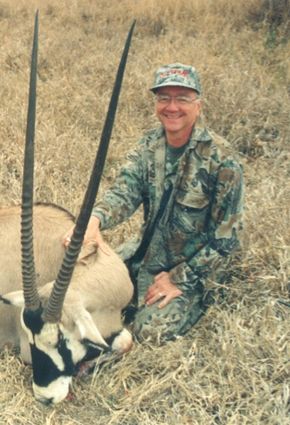6. Gemsbok---South Africa

Also known as oryx, they live in small herds in very dry areas and can go many days
without water. They are tan in color, with a striking black and white facial pattern,
and black stripes on the spine, legs, thighs and rump. The horns of the female are
often longer, but thinner than males. These horns are lethal weapons against predators.
A good bull will have horns over 36 inches, and anything over 39 inches is a dandy.
Telling bulls from cows can be tricky. The female’s horns may not be evenly straight.
One horn may bend slightly near the tip. One horn may be uneven, compared to the
other. This bull had horns that were 41 inches long.
HUNT DESCRIPTION

This great bull was taken on a bowhunt in South Africa in 1999. I sat in a tree blind
near a water hole and spotted this gemsbok when he was over 400 yards away. It was
the first gemsbok I’d ever seen in the wild. Over the next hour he worked his way
through the brush to the water. When he got there, and I was totally sure it was
a bull, I took the 29 yard shot. It was late in the evening, so we did not retrieve
him that night. Leaving animals out overnight in Africa is “iffy” because there are
so many predators that can find and consume them. However, we got lucky and found
him in perfect condition the next morning. He went 400 yards, but the trackers in
Africa have uncanny ability to follow animals and we made the recovery.